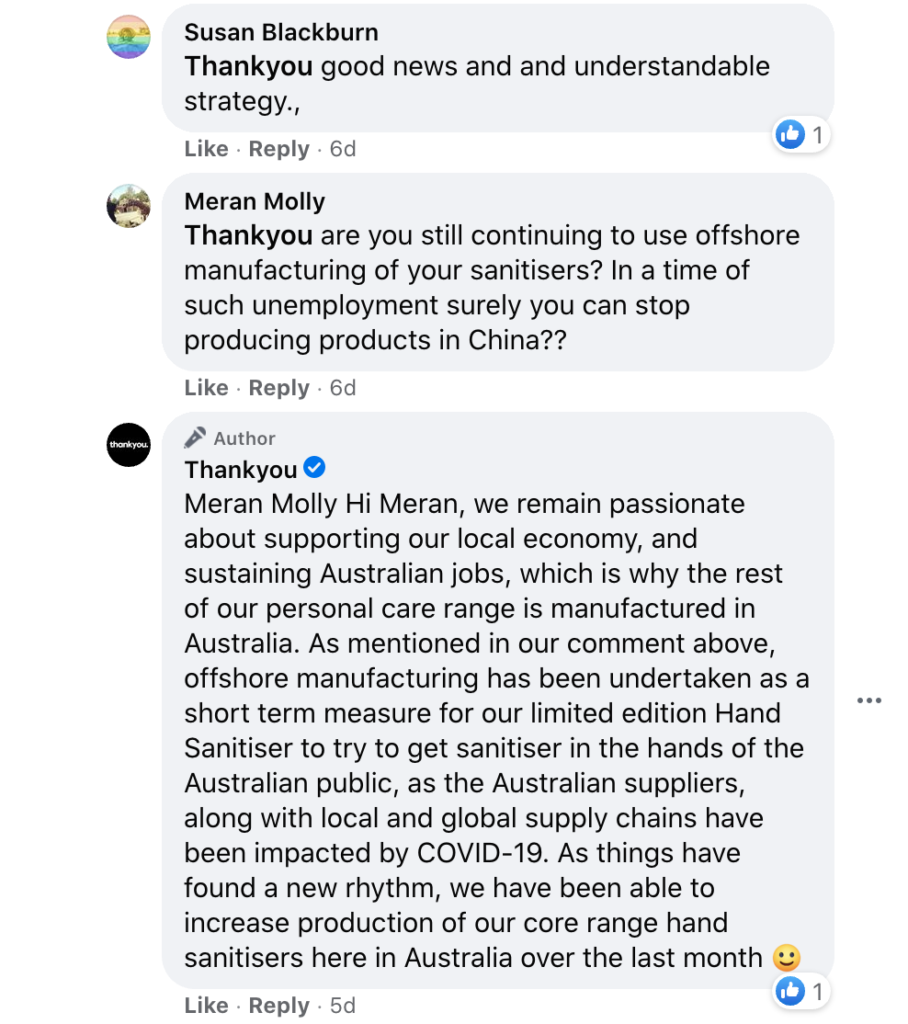In times like the present, there’s never been a greater need to view and treat your social media channels as a customer service tool. Sure, we can email or phone a business, but in reality, most of the time we want an immediate response and as we’re living in a digital world where we typically expect instant gratification, people tend to turn to social media and expect a timely response. However, businesses are often not meeting expectations.
With COVID-19 causing havoc across the globe, businesses are feeling the pressure. Most people are spending more time online and flooding to social media channels, which means there has never been a better time to reconsider how you use social media to support and grow your business.
Proactive and reactive community management
Responding to your messages and comments across social media channels is commonly referred to as ‘reactive community management’. This is an area where most businesses, of all sizes, are performing poorly. Too often, comments, questions and enquiries are not responded to, direct messages are ignored, reviews aren’t acknowledged, or businesses simply take several days to answer.
On the other hand, proactive social media management is taking the time to consider your community’s needs and incorporating this into your overall social media activity. This might be delivered by creating content aimed to address frequently asked questions, offering discounts, educating your audience and sharing news that’s of genuine value.
Rethinking your social media
Most businesses see social media as an opportunity to showcase their work, sell their products or share news and updates. Essentially, social media is often used as a digital billboard where businesses can share self-serving news and updates. However, they are missing out on the opportunity to build genuine engagement and relationships with their consumers. According to the Yellow Social Media Report 2020, just under a quarter of Australians (23%) use social media to keep up to date with brands, businesses, offers and promotions and this has increased even further during COVID-19. Sprout Social compared March 2020 to April 2020 and identified that on average, businesses saw 44 more engagements per day occurred across all social channels and industries, and 7.3 more engagements per post on average.
We explore some fundamental considerations for perfecting your community management on social media below:
Don’t be afraid of receiving negative comments or reviews
Businesses are often deterred from entering the social media landscape due to the fear of negative comments and or reviews. Yes, consumers have more power and influence than they have ever had before, but if you hold back due to fear, you’re also potentially missing the chance to hear from those who have had a good experience with your business.
It’s also worth reconsidering the way we view less than favourable commentary. Instead of looking at this as a negative, look at it as an opportunity. We can learn from customer feedback to improve products, services and overall customer experience.
There have also been countless examples of businesses’ that have successfully managed to respond to complaints in humorous and engaging ways and have even gathered mass community support. Woolworths won the respect of its community and even made headlines when channelling Ice Cube in a cleverly crafted response to a complaint on their Facebook Page.
It’s also worth noting that diversity in comments, complaints and reviews is to be expected as it’s impossible to please everyone all of the time. It also demonstrates credibility as people understand and appreciate that everyone’s experience differs.
Aside from everything else, if people have an unpleasant experience with your business, they are more than likely going to share their experience online regardless of whether your business is online. At least if you are, you have an opportunity to be a part of the conversation and to listen and learn from your customers’ experiences, instead of avoiding them.
To learn more, read our blog on managing trolls.
Who should be responsible for community management?
Community management is often seen as a junior position and while it may be depending on the social media channels in question, it is an important role and this position should be given the respect it deserves.
Like in a retail store, the person managing your social media is the front of house, they form part of your audience’s first impression, which means that it is important that this person, or persons, are given the training and support they require to perform their job well.
Your community manager needs to have strong customer service skills, the ability to work efficiently and think on their feet, and to work well within a team, as they will often need to source information to unexpected questions.
Tips to master your social media management
- While we think automation is sometimes overused, if you are being asked basic questions around things like open hours, contact info, Facebook’s Automated Responses can make your job a lot easier. If you’re on Instagram, you can set up Quick Replies. These functions can also be used to support responses to FAQs too.
- Take note of what people online are saying. This can be managed in a simple spreadsheet, or a social media management tool, but it’s important to track trends. As mentioned above, this feedback can be useful when considering content creation, as well as being able to improve customer experience across the board.
- Make sure you understand both your brand tone of voice and the tone of voice of the customers you are responding to. The saying ‘read the room’ needs to be considered in a digital space as well, particularly as you can’t convey body language, emotion or tonality. It’s also important to maintain a consistent tone of voice regardless of who is responding. It is worth ensuring social media is considered within both your editorial and branding style guide.
- Be forward-thinking. Where possible, try to predict what someone’s next question might be so you can give them as much information they need in the moment.
- Remember that social media engagement isn’t necessarily about people interacting directly with your brand. It is an incredible feeling when your fans unite together to form an online community based around your brand. A great example of this is Australian brand, Black Milk. Their fans refer to themselves as ‘Sharkies’ and have played a large part in growing the brand. They unite online in their love for the cult fashion brand and over the years, there have been various incarnations of fan lead groups and communities separate from the brand’s main channel. We must remember the ‘social’ in social media and understand that encouraging connection online plays a very important role in a brand’s ability to succeed.
- No matter how many processes and plans you have in place, don’t get stuck thinking that your social media is set and forget. Algorithms change, community and social politics evolve, which means you may need to look at content in a new way. If we consider the current climate, COVID-19 has changed a lot of things when it comes to social media. As we’ve addressed, people are spending more time online, they are more demanding when it comes to response times and even the time people are online has shifted. It’s important to consider this and to know when you need to evolve and pivot.
How can you create stronger community engagement?
As we have addressed, community management is both reactive and proactive. You don’t have to wait around for your followers to engage with your social media. Invite and encourage them to participate by using:
- Instagram polls, quizzes, ask me a question sticker
- Ask questions or for opinions
- Share surveys
- Share user-generated content
For more tips, read our blog on customer experience.
Who does it well?
Throughout this article, we have explored what it takes to successfully manage a social media community. Let’s take a look at some brands that are nailing it.
- Thankyou – Australian brand, Thankyou often respond to comments and questions from consumers, even tricky ones like their recent hand sanitiser post. They responded to, and acknowledged, questions around where the product was manufactured in detail showing transparency and accountability.

- Dindi Naturals – A natural skincare and body products brand, Dindi Naturals often acknowledge the kind comments people leave on their social media and also take note of requests from clients like this one.

As we have highlighted throughout, social media is an essential tool in delivering exceptional customer care and quality customer experience. While we have seen the importance of community management increase during COVID-19, in reality, many businesses have been well and truly lagging in this area. Hopefully, businesses of all sizes can use this time to review their current community management strategies and begin to improve and build on their delivery.
If you would like someone to review and or assist with your community management, please don’t hesitate to get in touch here.


2 thoughts on “Social Media: A Tool for Customer Care”